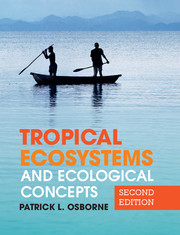Book contents
- Frontmatter
- Contents
- Preface
- Abbreviations and units
- Chapter 1 The tropical environment and climate
- Chapter 2 Dry, hot deserts and environmental factors
- Chapter 3 Grasslands and primary production
- Chapter 4 Savanna and population dynamics
- Chapter 5 Lakes, energy flow and biogeochemical cycling
- Chapter 6 Rivers, floodplains and estuaries
- Chapter 7 Wetlands and succession
- Chapter 8 Tropical rain forests and biodiversity
- Chapter 9 Mountains, zonation and community gradients
- Chapter 10 Mangroves, seagrasses and decomposition
- Chapter 11 Coral reefs and community ecology
- Chapter 12 Islands, archipelagos, biogeography and evolutionary ecology
- Chapter 13 Cities and human ecology
- Glossary
- References
- Index
- References
Chapter 6 - Rivers, floodplains and estuaries
the river continuum and flood-pulse concepts
Published online by Cambridge University Press: 05 June 2012
- Frontmatter
- Contents
- Preface
- Abbreviations and units
- Chapter 1 The tropical environment and climate
- Chapter 2 Dry, hot deserts and environmental factors
- Chapter 3 Grasslands and primary production
- Chapter 4 Savanna and population dynamics
- Chapter 5 Lakes, energy flow and biogeochemical cycling
- Chapter 6 Rivers, floodplains and estuaries
- Chapter 7 Wetlands and succession
- Chapter 8 Tropical rain forests and biodiversity
- Chapter 9 Mountains, zonation and community gradients
- Chapter 10 Mangroves, seagrasses and decomposition
- Chapter 11 Coral reefs and community ecology
- Chapter 12 Islands, archipelagos, biogeography and evolutionary ecology
- Chapter 13 Cities and human ecology
- Glossary
- References
- Index
- References
Summary
Rivers and streams have a one-way, downhill flow, and in these lotic (cf. lentic) environments, flow rate impacts the nature of plant and animal communities. Rivers also differ from standing waters in their longitudinal diversity. This change in riverine features from headwaters to mouth contrasts with the horizontal zonation (littoral to pelagic) and vertical stratification found in deep lakes. Even many large rivers are shallow and vertical stratification only occurs in slow-flowing, non-turbulent sections and in estuaries (see section 6.5). Some rivers do have deep sections – the lower reaches of the Amazon River, for example, are up to 100 m deep.
Many rivers, particularly in the tropics, also have significant interactions with the land lining the main river channel through inundation of this land, the floodplain. This lateral water movement, particularly in the lower reaches of many rivers, is frequently of greater ecological significance than the transport of materials and organisms from the upper catchment (Box 6.1). Organisms inhabiting floodplains are subject to an alternation of aquatic and terrestrial phases and exhibit a range of strategies that adapt them to this fluctuating environment. Floodplains play a significant functional role in the nutrient balance and energy flow within the river system, and the relationship between a river and its floodplain is both intimate and complex.
- Type
- Chapter
- Information
- Tropical Ecosystems and Ecological Concepts , pp. 204 - 240Publisher: Cambridge University PressPrint publication year: 2012



